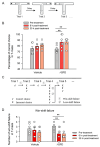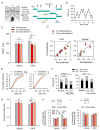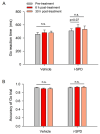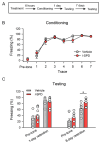Levo-Stepholidine as a Potential Cognitive Enhancer: Insights into Executive Function and Memory Improvements
- PMID: 39767588
- PMCID: PMC11727210
- DOI: 10.3390/biomedicines12122680
Levo-Stepholidine as a Potential Cognitive Enhancer: Insights into Executive Function and Memory Improvements
Abstract
Background/objectives: Levo-Stepholidine (l-SPD), a compound extracted from Chinese herbs, has the potential to treat psychotic disorders where cognitive deficits are a critical challenge. L-SPD displays a D1R agonism/D2R antagonism pharmacological profile, and its effect on cognitive function is still vague and lacks comprehensive study. Here, we investigated the impact of l-SPD on two core indexes of executive function, working memory and response inhibition, and learning and memory.
Methods: Using a delayed alternation T-maze task (DAT), we investigated the impact of l-SPD on working memory, evaluated its effect on response inhibition using the stop-signal task (SST), and assessed the impact on learning and memory using trace fear conditioning in Sprague-Dawley rats. We further evaluated its effects on prefrontal glutamate receptor expression using western blot.
Results: Rats receiving l-SPD made fewer errors in the T-maze, exhibited faster stop action in response to the stop signal, and showed longer-lasting memory retention. Molecular mechanism investigations reveal that l-SPD upregulates the expression of prefrontal glutamate receptors. These results demonstrate that l-SPD improves executive function and memory.
Conclusions: Here, we show the enhancement effect of l-SPD on cognitive function, which provides essential implicants for the treatment of cognitive deficits, which is a critical unmet need in psychiatric care.
Keywords: Chinese herb; D1 receptor agonist; D2 receptor antagonist; Sprague-Dawley rats; antipsychotic agents; cognition; executive function; glutamate receptors; memory; prefrontal cortex.
Conflict of interest statement
The authors declare no conflicts of interest.
Figures







Similar articles
-
Activation of D1R/PKA/mTOR signaling cascade in medial prefrontal cortex underlying the antidepressant effects of l-SPD.Sci Rep. 2017 Jun 19;7(1):3809. doi: 10.1038/s41598-017-03680-2. Sci Rep. 2017. PMID: 28630404 Free PMC article.
-
Molecular insights into the D1R agonist and D2R/D3R antagonist effects of the natural product (-)-stepholidine: molecular modeling and dynamics simulations.J Phys Chem B. 2012 Jul 19;116(28):8121-30. doi: 10.1021/jp3049235. Epub 2012 Jul 3. J Phys Chem B. 2012. PMID: 22702398
-
Evaluation of the antipsychotic effect of bi-acetylated l-stepholidine (l-SPD-A), a novel dopamine and serotonin receptor dual ligand.Schizophr Res. 2009 Nov;115(1):41-9. doi: 10.1016/j.schres.2009.08.002. Epub 2009 Sep 9. Schizophr Res. 2009. PMID: 19744833
-
[Cognition, schizophrenia and the effect of antipsychotics].Encephale. 2006 May-Jun;32(3 Pt 1):341-50. doi: 10.1016/s0013-7006(06)76162-0. Encephale. 2006. PMID: 16840928 Review. French.
-
Recent developments in studies of l-stepholidine and its analogs: chemistry, pharmacology and clinical implications.Curr Med Chem. 2007;14(28):2996-3002. doi: 10.2174/092986707782794050. Curr Med Chem. 2007. PMID: 18220736 Review.
References
-
- Shahrokh N.C., Hales R.E., Phillips K.A., Yudofsky S.C. The Language of Mental Health: A Glossary of Psychiatric Terms. American Psychiatric Publishing; Arlington, VA, USA: 2011.
-
- Sabe M., Pillinger T., Kaiser S., Chen C., Taipale H., Tanskanen A., Tiihonen J., Leucht S., Correll C.U., Solmi M. Half a century of research on antipsychotics and schizophrenia: A scientometric study of hotspots, nodes, bursts, and trends. Neurosci. Biobehav. Rev. 2022;136:104608. doi: 10.1016/j.neubiorev.2022.104608. - DOI - PubMed
Grants and funding
LinkOut - more resources
Full Text Sources

